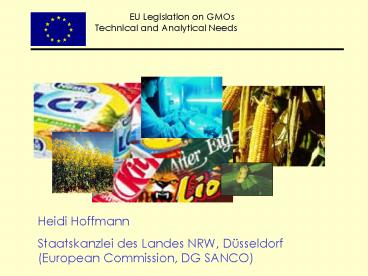EU Legislation on GMOs - PowerPoint PPT Presentation
1 / 13
Title:
EU Legislation on GMOs
Description:
transferring genes into crop plants to make them more resistant to insect pests ... adventitious presence of GMOs or GM material in food during cultivation, harvest, ... – PowerPoint PPT presentation
Number of Views:121
Avg rating:3.0/5.0
Title: EU Legislation on GMOs
1
EU Legislation on GMOs Technical and Analytical
Needs
Heidi Hoffmann Staatskanzlei des Landes NRW,
Düsseldorf (European Commission, DG SANCO)
2
The Europeans and Biotechnology Public
Perception
- Eurobarometer 2000 16 000 persons in 15 M/S
(www.europa.eu.int) - bt will improve our way of life in the next 20
years - yes 41 - Morally acceptable
- produce medicines or vaccines
- developing genetically modified bacteria to
clean spillages of oil or dangerous chemicals
Not so critical - transferring genes into crop plants to make them
more resistant to insect pests Morally
unacceptable - using modern biotechnology in the production of
foods - would you sign a petition against bt - yes 39
- no 38 - Europeans are not technophobes but are not
enthusiastic about biotechnology
3
The Europeans and GM food
- Eurobarometer 2001 (www.europa.eu.int)
- 'Is GMO based food dangerous ?' yes (56.5),
no opinion (26.5) - I want to have the right to chose when it comes
to GMOs' yes (94.6) - 'I want to know more about the food before
eating it yes (85.9) - GMOs should only be introduced if it is
scientifically proven that they are
harmless yes (85.8)
4
EU Legislation on GMOs
Introduction of EU legislation in
1990 protect health and the
environment create a unified market for
biotechnology Principle cultivation / placing
on the market only after authorisation based
on risk assessment case-by-case basis
5
EU Legislation on GMOs
Council Directive 90/219 on the contained use
of GMMOs, amended by Council Directive
98/81/EC Directive 90/220 of the EP and the
Council on the deliberate release into the
environment, amended by Directive 2001/18/EC (17
October 2002) Part B for experimental releases
(1700 in the EU, http//gmoinfo.jrc.it) Part C
for placing on the market 18 GMOs approved14
pending applications (since 1998 no approval)
6
Genetically Modified Food
Regulation No 258/97 of the EP and of the Council
concerning novel foods and - ingredients single
safety assessment Community system for placing
on the market labelling 12 pending
applications 12 notified products oil
produced from GM rape seed starch and -
derivatives from GM maize riboflavin from GM
Bacillus subtilis
7
Genetically Modified Feed
No specific EU legislation on GM feed in place 8
products authorised in accordance with Directive
90/220 four maize varieties three rape seed
varieties one soya variety Only four
varieties have to labelled (Amendment of
90/220 in 1997) No specific legislation for
feedingstuff produced from GMOs is in place
8
Labelling of GM food
- Novel Foods Regulation No 258/97 article
8 concept of equivalence - Council Regulation No 1139/98 Roundup Ready
soya Bt 176 maize - Commission Regulation No 50/2000 additives and
flavourings - principle labelling if DNA or protein
resulting from the genetic modification is
detectable
9
Threshold for Labelling
- Commission Regulation 49/2000
- adventitious presence of GMOs or GM material in
food during cultivation, harvest, transport or
processing - threshold of 1 (on ingredient level) for
approved GMOs - tries to solve the problem of operators who do
not use GMOs and can prove this by documentary
evidence Article 21(2) of Directive 2001/18/EC
10
Control and enforcement
Member States are responsible for enforcement
and control (EU Treaty) placing on the
market labelling All M/S have designated
authorities and facilities for the control of
GMOs and GM-products Commission has
responsibility for ensuring the proper
functioning and development of the single
European market The aim is to ensure that EC
food law is enforced with the same rigor in all
Member States.
11
Technical and Analytical Needs
- Under the current legislation complex controls
in the final product are necessary - Testing
- with qualitative methods (yes / no)
- with quantitative methods (compliance with the 1
threshold for labelling) - Necessary
- validated methods
- control samples (reference materials)
- specific tests to distinguish EU-approved and
non- approved GMOs - development and exchange of testing methods and
reference materials on international level (CEN,
ISO Cartagena Protocol on Biosafety, OECD, CODEX
Alim.)
12
ENGL - A Success Story
In 1999 the Joint Research Centre of the
Commission (JRC) started co-ordinating a network
of GMO laboratories from EU-Member States with
the main objective to develop validated test
methods and appropriate reference samples and to
promote a harmonised approach of means and
methods European Network of GMO laboratories,
ENGL 45 control laboratories capable of testing
seed, grains, food, feed, environmental
samples Acting as a scientific and technical
pan- European network of excellence
13
Future EU Legislation on GMOs
- In future operators will have to provide
detection methods and control samples/access to
reference materials at the time of application
for authorisation - JRC as Community Reference Laboratory shall test
and validate the proposed method, assisted by
European Network of GMO Laboratories (ENGL) - Methods will be available to the
public/operators in the feed-food chain via a
public register - makes regulatory framework more operational
ensures harmonised control and enforcement - Contribution to build up public confidence































